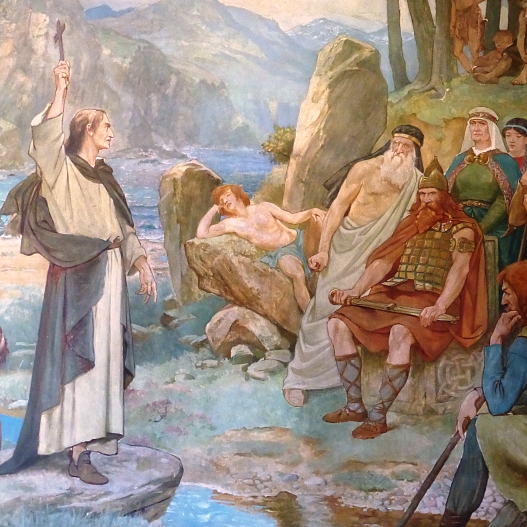In the year that St. Columba died, 597, the Catholic missionary St. Augustine arrived in England; his mission, to convert the Anglo-Saxons. However, the Celtic church was already established and had consequently assimilated many of the pagan deities into its beliefs and converted a significant number to the religion. Conflicts arose as Celtic Christianity and Roman Catholicism competed for converts, status and lands.
Even though the Celtic missionaries effectively spread word of their church throughout western and central Europe, the Celtic church was on the losing side of a power struggle with the centralized church of Rome. One of the reasons for this was Celtic monasticism.
Monastic life under the rule of St. Columba was severe and invariable. The alternative, Benedictine rule, was much more compassionate to the daily needs of its brethren and thus more attractive to prospective monks. Also, unlike the independent Celtic monasteries, the Benedictines had a centralized command structure. In time, the Benedictine rule replaced the harsher disciplines of self-denial demanded by the Columbanian rule in the Celtic-founded monasteries. In some places, the transition was more gradual, with an interval that used a mixed rule based partly on the Columbanian and partly on the Benedictine.
The downfall of Celtic Christianity can be traced to Northumbria in the middle of the seventh century. King Oswald, a Celtic Christian, at the bidding of his wife Eanfled, a Roman Catholic, summoned a church meeting. The meeting was not originally called to settle a doctrinal difference. Rather, it was due to the fact that the Celtic and Catholic churches used different calendars. This meant that each church celebrated the movable feasts, such as Easter, on different dates. Thus, within the Northumbrian court, there were two Christian observances that conflicted with one another. When the Celtic Christians were feasting at Easter, the Catholics were still fasting in their period of Lent.
King Oswald presided over the gathering at the monastery of Steaneshalch (Whitby) which included a Celtic delegation from Holy Island (Lindisfarne) led by Abbot Colman, and a delegation represented by Abbot Wilfrid from Ripon. Bishop Cedd of Essex served as a translator between the Gaelic-speaking Celts and the Anglo-Saxons.
Oswald knew from his wife and her advisor, the Catholic priest Romanus, that the Catholics would completely reject changing to the Celtic calendar so he began by asking Colman to justify the tenets of the Celtic tradition. Wilfrid, the more eloquent of the two representatives, when given his turn to speak attacked the very foundation of the Celtic Church by saying it was built on the teachings of Columba rather than St. Peter, the founder of the true church.
Ultimately, Oswald decided to replace the usage of the Celtic church with the Roman Catholic practice, stating, "When I come to the gates of heaven, there will be no one to open them". On the grounds that St. Peter, rather than St. Columba, held the keys to heaven the Celtic church was forced to give way to the Catholic church. The Celtic priests who would not accept Oswald's decision were expelled immediately. From Lindisfarne, Colman, accompanied by a party of monks traveled to Scotland, carrying with them holy relics, the bones of St. Aidan. In Scotland, the Celtic church did not recognize Oswald's resolution which came to be known as the Synod of Whitby, but the Catholic church now had Celtic Christianity on the decline.
In 670, another synod was convened at Autun which made the Benedictine rule mandatory in all monasteries in France and decreed that Celtic rule would be abolished there.
Despite the synods of Whitby and Autun, which eradicated Celtic Christianity in England and France, the Celtic church flourished in Scotland and Ireland, continuing the longest in areas of Scotland where, in 1069 the Celtic church was officially abolished by King Malcolm Canmore. However, in remote areas, isolated groups of Scottish Celtic monks continued to practice their religion in secret until the fourteenth century.

The Anglo-Saxon conversion in particular was a gradual process that necessarily included many compromises and syncretism (combining of different beliefs) ... Read more at Wikipedia.

The gods and goddesses of the pre-Christian Celtic peoples are known from a variety of sources, including ancient places of worship, statues, engravings, cult objects and place or personal names. Read more at Wikipedia